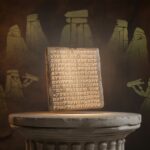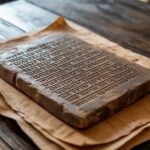1.Mummy Powder—Crushed Human Remains Used as a Healing Agent
If you think modern medicine has had its questionable moments, wait until you hear about “mummia.” From the 12th to the 17th century, European apothecaries stocked their shelves with a substance made from ground-up Egyptian mummies—yes, actual human remains. Known as mummy powder, or simply “mummia,” this macabre remedy was believed to cure everything from epilepsy and bruises to internal bleeding and migraines. It was consumed in wine, mixed into ointments, or sprinkled directly onto wounds. The reasoning? People thought that the preserved flesh of ancient Egyptians retained some sort of mystical life force—an early and rather literal take on “you are what you eat.”

The confusion began with a mistranslation. The original Arabic word mūmiyā referred to a natural bitumen used medicinally in Islamic and Persian traditions. But European physicians misinterpreted it to mean the resinous remains of embalmed corpses, and the market for mummies exploded. Demand became so high that when authentic Egyptian mummies ran low, enterprising merchants turned to fakes—using the bodies of criminals or plague victims, artificially dried and passed off as the real deal.
Not everyone bought into the trend. In the 16th century, French surgeon Ambroise Paré publicly denounced the practice, calling it ineffective and ethically troubling. Still, mummy powder persisted in European medicine until the 18th century, a chilling reminder of how far belief can carry a bad idea. Even more bizarre? The same crushed remains were used by painters to create “mummy brown,” a pigment prized in art studios well into the 20th century. Turns out, history’s appetite for the exotic didn’t stop at the canvas—or the prescription pad.
2.Mercury—A Toxic Metal Once Believed to Cure Everything
Mercury, a shimmering liquid metal once called “quicksilver,” wasn’t just a scientific curiosity—it was a staple in medicine cabinets for centuries. From the 15th through the early 20th century, physicians across Europe, Asia, and the Americas turned to mercury compounds as supposed cure-alls for everything from constipation to melancholia. But no condition attracted more mercury-based prescriptions than syphilis. Long before antibiotics, doctors believed mercury could purge the body of the infection, often administering it through ointments, pills, steam baths, and even fumigation.
One of the most infamous mercury-based remedies was the “blue mass” pill, a chalky concoction of mercury, licorice root, and rosewater. It was so common that even Abraham Lincoln reportedly took it for melancholia—though historians now believe his erratic behavior during that period may have stemmed from mercury poisoning. Another variant, calomel (mercurous chloride), was routinely given during the 18th and 19th centuries as a laxative and treatment for yellow fever. During the American Civil War, it was so widely used that soldiers began showing signs of mercury toxicity en masse—tremors, tooth loss, neurological damage, and kidney failure.
Despite these devastating side effects, the medical establishment clung to mercury, misinterpreting symptoms of poisoning—like excessive salivation—as signs that the treatment was “working.” It wasn’t until the discovery of Salvarsan in 1910 and penicillin in the 1940s that mercury therapies finally fell out of favor. Today, mercury is recognized as a potent neurotoxin with no place in modern medicine, serving as a sobering reminder of how yesterday’s miracle cure can become today’s cautionary tale.
3.Animal Dung—Used to Treat Wounds and Infections
When we think of historical medicine, we might imagine herbal brews or leech therapy—but a salve made from animal dung? That’s not just folklore; it was a common practice across ancient and medieval civilizations. From the Nile Valley to medieval Europe, animal excrement was believed to possess curative powers, especially when it came to treating wounds and infections. Ancient Egyptian physicians, whose medical knowledge was recorded in texts like the Edwin Smith Papyrus (circa 1600 BCE), prescribed mixtures of donkey, gazelle, and even fly dung to combat inflammation and promote healing. The rationale? Some believed the fibrous, plant-rich waste of herbivores had natural antimicrobial properties—a hypothesis that modern microbiology partially supports, albeit with many caveats.

In medieval Ireland and England, powdered dog dung—especially from animals that ate bones—was often mixed with honey and applied to open wounds, while pigeon droppings were included in plasters to treat gout and vertigo. Even more striking, crocodile dung was used as a contraceptive in ancient Egypt, inserted intravaginally as a barrier—an early, if questionable, form of birth control. In Indian Ayurvedic medicine, cow dung and urine were (and in some rural areas, still are) applied to burns and skin infections, believed to detoxify the body and balance internal energies.
Despite the occasional presence of antibiotic-producing bacteria in herbivore dung, the risks far outweighed the benefits. Pathogens, parasites, and tetanus spores lurked in these substances, making them hazardous by today’s standards. And yet, in eras where antiseptics were nonexistent and infections could be fatal, people turned to what was available—no matter how unsanitary it might seem now. Animal dung in medicine wasn’t just a desperate measure; it was, for centuries, a legitimate attempt to harness nature’s resources in the fight against disease.
4.Urine—Applied for Cleaning and Disinfection
Urine, perhaps one of the most unexpected substances in the annals of historical medicine, was once considered a versatile and even essential tool in both diagnosis and treatment. Long before the advent of antiseptics or antibiotics, ancient and medieval practitioners turned to urine for its perceived cleansing and healing properties. Its application wasn’t limited to one culture or era—civilizations from ancient Egypt and Rome to Renaissance Europe all found medicinal uses for this bodily fluid. Why? Because fresh human urine contains ammonia, a compound with natural disinfectant qualities. To early healers, it seemed like nature’s own antiseptic.
In ancient Rome, for instance, urine wasn’t just used in medicine—it also played a central role in the textile industry. Fullers, or cloth cleaners, soaked garments in vats of urine to cleanse and soften fabrics, taking advantage of its ammonia content to break down dirt and grease. This practical knowledge likely influenced its use on the human body, where it was applied to wounds, burns, and skin infections. Medieval medical texts even advised urinating directly on open wounds to prevent infection—an early, if misguided, attempt at sterilization.

The practice extended into diagnostic medicine as well. Through a method known as uroscopy, physicians in the Middle Ages examined the color, clarity, and even taste of a patient’s urine to diagnose everything from liver disease to pregnancy. In fact, urine flasks became iconic symbols of physicians during the Renaissance, often depicted in paintings and manuscripts.
But perhaps the most eyebrow-raising use was in oral hygiene. Some ancient cultures, including the Romans, believed that gargling aged urine helped whiten teeth and freshen breath—an idea that, while revolting by today’s standards, was rooted in the belief that ammonia could cleanse the mouth. While urine is sterile when first expelled, modern science has shown that it quickly becomes a breeding ground for bacteria, making such practices risky rather than curative.
Although today we recoil at the thought, the historical use of urine reveals just how far people have gone in the pursuit of healing—and just how creative (or desperate) pre-modern medicine could be.
5.Moldy Bread—An Early Form of Antibiotic Treatment
Long before Alexander Fleming’s 1928 discovery of penicillin changed medicine forever, ancient healers were already harnessing the antibacterial power of mold—albeit unintentionally. In civilizations like ancient Egypt, Greece, and China, physicians applied moldy bread directly to wounds, believing it could help prevent infection and speed up healing. They weren’t wrong. While they lacked microscopes or germ theory, what they did have was empirical observation—and a bit of luck. The mold that often colonized stale bread, particularly strains of the genus Penicillium, naturally produced antibiotic compounds capable of inhibiting bacterial growth. In essence, these early practitioners were using nature’s pharmacy thousands of years before science caught up.

The Egyptians, for example, documented the use of moldy substances in medical papyri dating back to 1500 BCE. Across the Mediterranean, Greek physicians like Galen would later echo similar practices in treating wounds. Even in ancient China, writings describe the application of fermented soybean curd and moldy textiles to infected skin. While these treatments were not standardized, their recurring presence across cultures suggests a shared recognition of mold’s healing effects.
It wasn’t until the 20th century that scientists finally understood why these folk remedies worked. Fleming’s accidental revelation—that Penicillium notatum secreted a substance lethal to bacteria—validated what healers had been doing for millennia. Today, moldy bread might seem like a culinary mistake, but in the ancient world, it was a crude yet effective stand-in for modern antibiotics. And perhaps the most astonishing part? It worked—sometimes better than the bleeding, purging, or mercury treatments that came centuries later.
6.Crushed Gemstones—Thought to Hold Magical Healing Powers
In an age when science bowed to symbolism and alchemy still flirted with medicine, crushed gemstones weren’t just wearable luxuries—they were swallowed, sprinkled, and stirred into potions as if they held the key to life itself. Across centuries and civilizations, from the opulent courts of Renaissance Europe to the temples of ancient India, powdered gems were believed to carry mystical curative powers. Why? Because in the worldview of historical medicine, rarity and radiance were signs of divine favor—and what better vessel for healing than something born of the earth and forged under immense pressure?
In ancient Egypt, physicians referenced in the Ebers Papyrus—one of the oldest known medical texts, dating to c. 1550 BCE—used stones like hematite to stop bleeding and reduce inflammation, while lapis lazuli was prized for its supposed spiritual and physical benefits. In Ayurvedic medicine, pearls were powdered and prescribed to calm the mind and promote longevity, while rubies were said to “warm the blood” and stimulate vitality. The Greeks had their own gemstone prescriptions: Pliny the Elder claimed emeralds could cure eye ailments, and amethysts were believed to ward off drunkenness—hence the name, from the Greek amethystos, “not intoxicated.”
By the Middle Ages and into the Renaissance, European physicians—especially those serving nobility—were compounding gemstone powders into elixirs. Ruby powder was thought to purify the heart, emerald to treat epilepsy, and sapphire to cool fevers and restore eyesight. Even diamond dust, despite its abrasive dangers, was administered in minute doses as a supposed cure-all. These treatments weren’t cheap: only the wealthiest could afford them, which added to their allure and mystique. Royal apothecaries ground gems into tonics and pills, sometimes mixing them with herbs or gold leaf, creating concoctions that were as much status symbols as they were “medicine.”
Modern science, of course, has since shown that ingesting gemstones offers no measurable health benefit—and in some cases, as with powdered diamond or lead-based stones like galena, could be fatally toxic. But the enduring belief in their power speaks volumes about the intersection of beauty, belief, and the human desire to heal. Even today, crystal healing enjoys a cult following, albeit more spiritual than medicinal. So while we no longer grind up rubies for stomach cramps, the idea that something so rare might fix what ails us? That’s a notion that never quite lost its sparkle.







